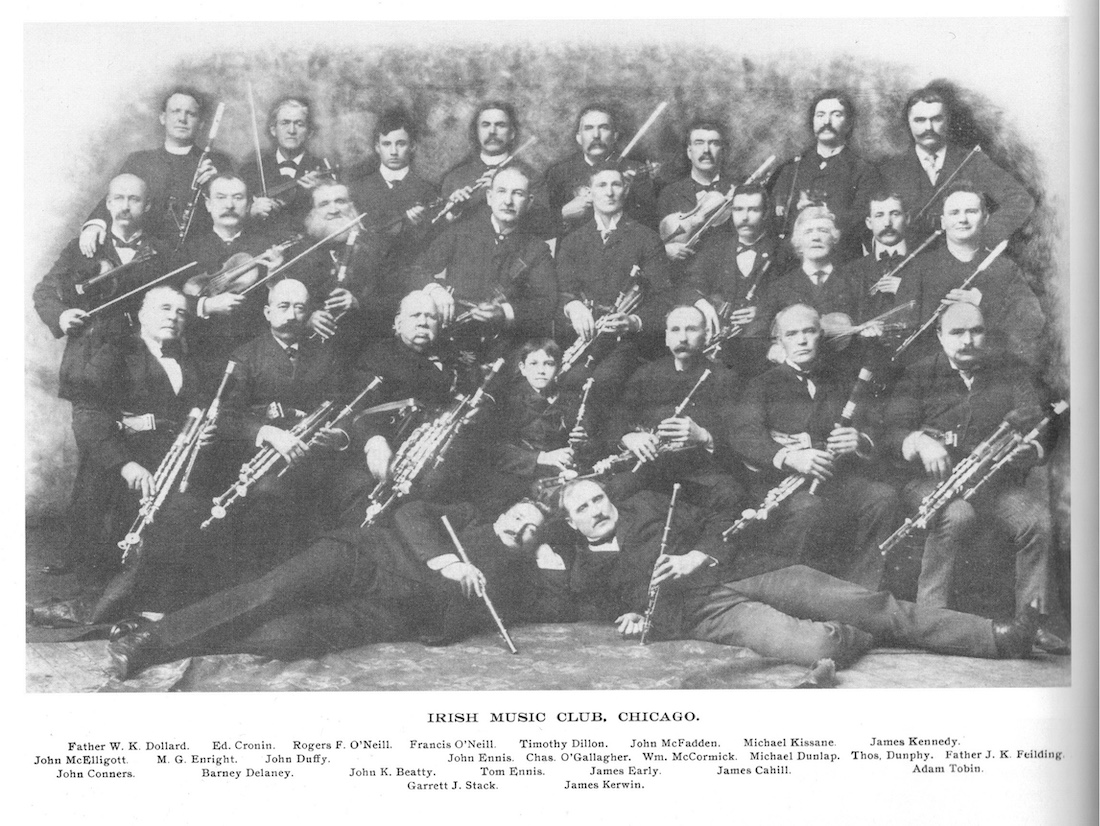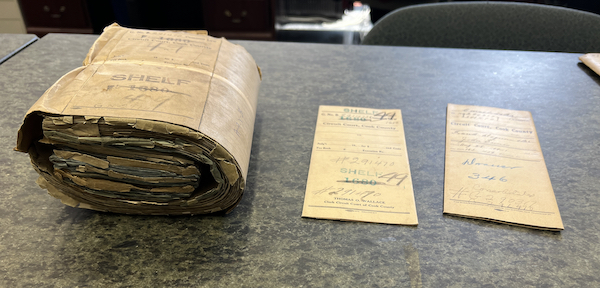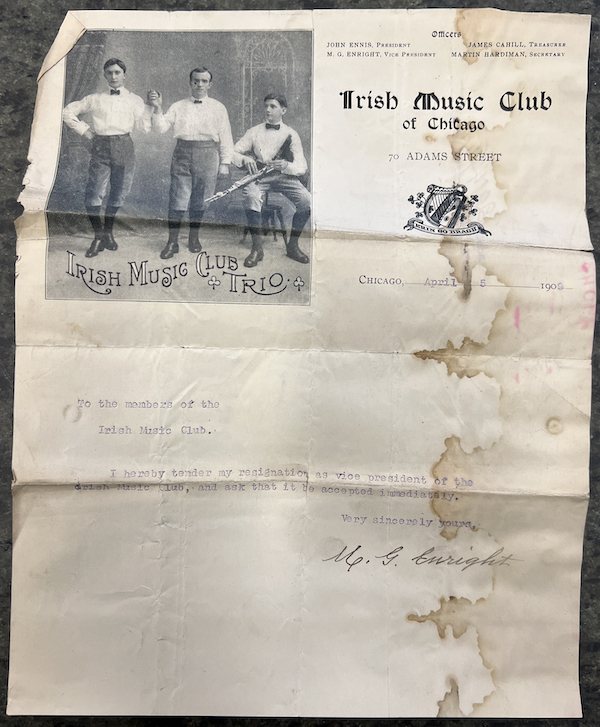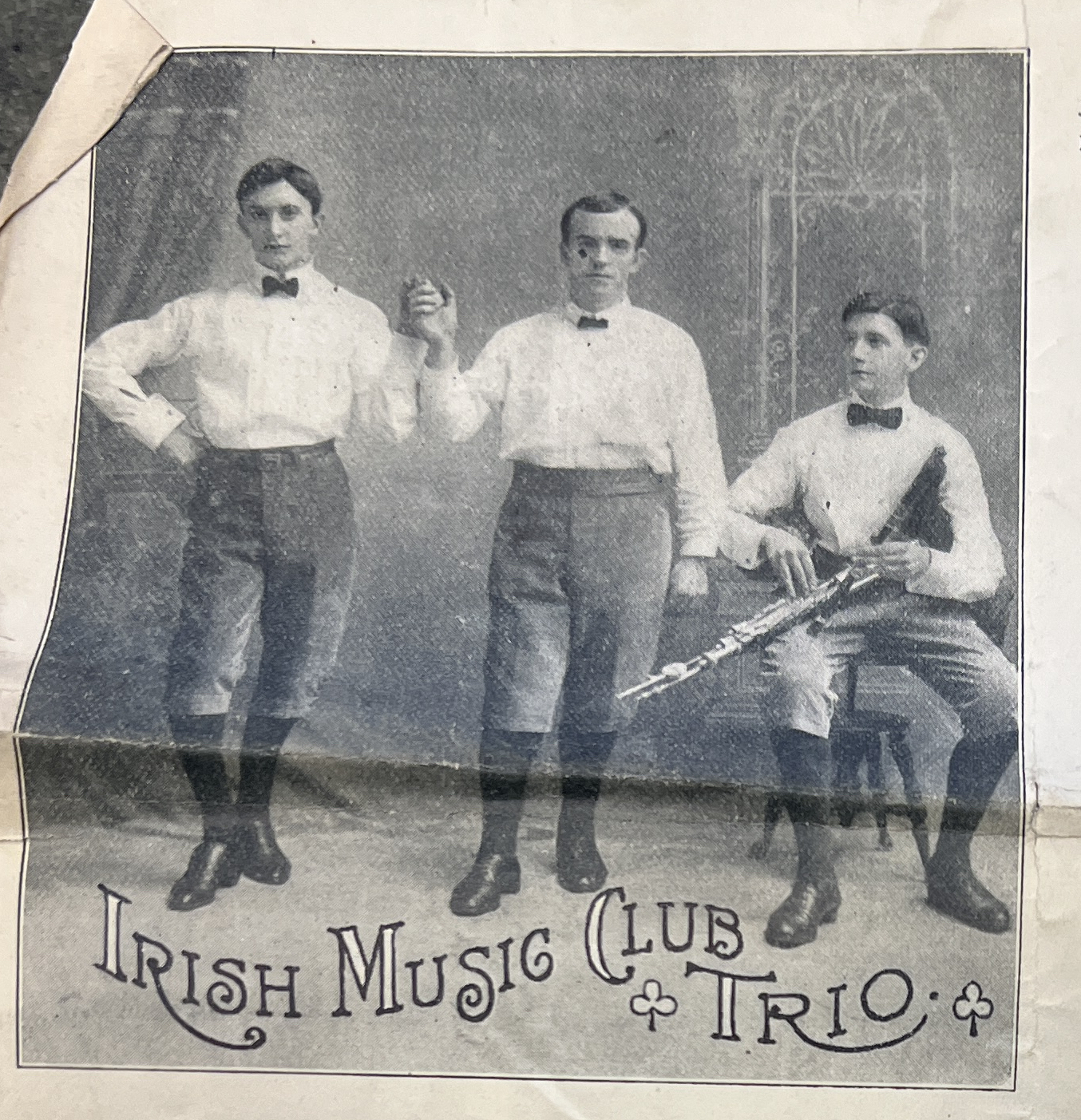Irish Music Club of Chicago court cases 1909
[First published in An Píobaire vol. 21 no. 1 Feb. 2025 pp. 33-40]

The best-known trace of the Irish Music Club of Chicago is a group photograph in Francis O'Neill's book Irish Minstrels and Musicians (1913, p. 479). The photo, probably taken before 1902, shows 26 people, among them the elite of Chicago's Irish musicians, including Francis O'Neill, John McFadden, John Ennis, Barney Delaney and James Early. The club was successful and a center of Irish musical activity for several years. But O'Neill acknowledged club president John Ennis could be an unpleasant, headstrong person, and by the time of the court cases in 1909, most of the best regarded musicians had left the club.
A Summary
The Irish Music Club of Chicago was officially formed in 1902 and John Ennis was its first and continuing president.
The court cases were an aggressive reaction to John Ennis' high-handed management of the club, when in 1909 a group of members, most of them younger and interested in dancing, took him up on his threat to resign, elected themselves officers, then sued Ennis & his son Thomas and other officers. The big issues were 1) Ennis' authoritarian handling of money and club records and 2) his unwillingness to consider non-Irish music & dances at club events (no "German" music, or two-steps or waltzes). One suit, against John Ennis, asked that Ennis hand over club records and money to the new officers. A second suit, against Thomas Ennis, his son, and others, asked that they be forbidden to use the club's name in sponsoring club events. The two suits, in the Circuit Court of Cook County, were consolidated in court procedures. The court sided with John Ennis, the suits dismissed. New officers were again elected, with son Thomas Ennis as president.
The Narrative
The Irish Music Club of Chicago was organized July 20, 1902. According to the club's published "By-laws and Rules"
- The objects and aims of this Club shall be to revive, cultivate and disseminate the ancient Irish music, dances and songs. To promote sociability and good-fellowship among its members. To encourage and facilitate the traditional method of playing and singing Irish music, and to provide the opportunity, from time to time, for its members to indulge in and enjoy the same.
All members "shall be of Irish birth or descent." Officers were elected for one year terms, starting in July. Meetings were held once a month to transact business and to play music, sing and dance. Members who did not show for three consecutive meetings were considered to be in "bad standing" and risked being dropped from the rolls. Initiation fee was $1.00, changed to $3.00 in 1903. Dues were 25 cents per month.1 At the time of the lawsuits in 1909 there were 63 members.2
Besides monthly meetings, the club held an annual Feis Ceoil and Ball 1903-10, and an annual picnic and outing 1903-10, perhaps 1911. It published lyrics to two songs, 1905, 1908. In February 1904 the club held a reception for Pat Touhey, "the celebrated Irish piper"; he was an honorary member. At least through 1909 the club rented Liberty Hall, on the second floor of the Fraternity Halls Building, 70 Adams Street. They had the third Saturday evening of each month, cost $90.00 per year.3 The hall was sometimes referred to as the club's headquarters.
President John Ennis was the most active organizer and manager of the club. He was the club's first president, 1902-1909. He testified that he had written the minutes of club meetings at least since 1906, absolving the secretary of work. In 1909 he was the keeper of the club's business and financial records. At every monthly meeting Ennis would ask for silence: "I always do that every meeting, have something to say about the business of the club, about its objects and aim, and so forth."4 His accounts of club special events were published in newspapers. Ennis, and at least in 1909 vice president Michael Enright, stood surety for the rental of Liberty Hall.
Ennis had become tired of club duties: "For several years I wanted to resign; at each annual meeting I requested them to elect somebody else..."5
Martin Hardiman was elected secretary July 1908.6 Hardiman was a dancer and dance teacher, and associated with the well-known Chicago dancing teacher John E. McNamara, also a club member.7 Hardiman chafed at Ennis' leadership and wrote him a letter of complaint and suggestion shortly before the March 20, 1909 monthly meeting. Hardiman, and others who signed the letter, complained of excessive control and what today might be called a lack of transparency in leadership. He also suggested the club permit "dances and music of an American character," not exclusively Irish music and dance.8
Ennis was deeply offended and read the letter at the March 1909 meeting. He threatened to resign. Ennis and vice president Enright left the meeting, along with more than half of the members present. This created a schism in the club. The remaining members elected new officers on the spot. Strangely enough, Thomas Ennis, John Ennis' son, stayed at the meeting and was the one to nominate Frank Degnan for president.
The new officers were Frank Degnan president, John McNamara vice president and John Bolton treasurer. Martin Hardiman remained as secretary. At this point John Ennis and Michael Enright had not officially resigned as president and vice president. Members sympathetic to Ennis and Enright (including Thomas Ennis!) called a meeting for April 5 to elect officers. John Ennis and vice president Enright submitted letters of resignation on that day.9 At the meeting president Degnan rejected the meeting's purpose and argued that he and McNamara and Bolton were properly elected. Degnan and his supporters left. This split the club into two factions. Members who remained at the meeting elected another set of officers: Thomas Ennis president, Mrs. Robert McGuire vice president, Michael O'Hearn treasurer and James K. McInerney secretary.
Degnan and his supporters claimed to be the proper club. They obtained a certificate of incorporation from the State of Illinois for the Irish Music Club of Chicago on April 9, 1909 with Degnan president, Hardiman secretary, Bolton treasurer. They wanted an accounting of club money received by John Ennis.10 To this end they brought suit against John Ennis in the Circuit Court of Cook County, Frank Degnan, et al vs John Ennis, April 15. (The court consistently used et al. without a period.)
John Ennis and his supporters in the meantime continued their claim to be the real Irish Music Club and gave "social entertainments."11 As a consequence the Degnan faction sued Thomas Ennis, June 17, Irish Music Club of Chicago vs Thomas Ennis, et al, seeking to prohibit him and others from using the club's name to sponsor events.
The two cases were consolidated and the court appointed a Master in Chancery, Wm. Fenimore Cooper, to gather evidence and take testimony and report to the court his conclusions on the two cases. Hearings took place July 16, 19, 20, 1909. He took testimony from "John Bolton, John Ennis and other witnesses." Relevant documents were assembled and 137 pages of testimony were transcribed.
During the testimony the lawyers spent much time on disputed procedural questions. Was the March 20 meeting a business meeting or a social meeting? Were the club's by-laws followed? Was there a quorum? When exactly did Ennis and Enright resign? And so forth.
The Master concluded there was no evidence John Ennis retained any money intended for the club, and no accounting was necessary.12 The judge later agreed with this finding.
The Master found that the election of Degnan, McNamara and Bolton was valid, but good only for the remainder of the term of the resigned officers, which ended on the second "Sunday of July, 1909, at which time this cause was pending in the courts," and no election held.13 Ultimately the judge did not agree with this finding.
The Master recommended that another election be held with all the members of the original club participating.14 The judge did not agree with this recommendation. The Master also recommended that the club go forward as Irish Music Club of Chicago, incorporated.15
The Master's Report was submitted to the Court Aug. 6, 1909. Court costs were apparently $75.55,16 equivalent to about $2,600 in 2024.
Circuit Court Judge Paul McWilliams handed down a decree August 28, 1909.17 He judged that officers elected April 5, that is, Thomas Ennis, Mrs. R. McGuire, Michael O'Hearn and James K. McInerney were the "lawful officers." All complaints of Degnan et al. were dismissed and they were ordered to pay court costs. The decree did not give reasons for the Judge's decision.
There is no record that the case was appealed.
The club was active for a couple more years. The slate of officers was reaffirmed at the club annual meeting October 9, 1909. A new president, John J. Ryan, was elected in 1910, along with "recording secretary" John Ennis. At the annual meeting in July 1911, the last one known, the officers were John Ennis president, James K. McInerney vice president, M. J. O'Heron treasurer and M. G. Enright secretary. Mention of this annual meeting was the last contemporaneous newspaper reference to the club.
Young vs Old
John Ennis was 61 years old in 1909, M. G. Enright 56 years old, both born in Ireland. Ennis testified that at the 1906 annual meeting he had recommended that young and energetic members be elected to the board of directors. Perhaps this is one reason Martin Hardiman, age 20 in 1909, was elected secretary in 1908. He was employed as a bookkeeper at the time.18
Hardiman felt he was secretary in name only, and wrote this in his letter to John Ennis, according to Ennis' testimony.19 Club members Frank Degnan (age 24), John McNamara (age 35) and John Bolton (age 24) sympathized with Hardiman. At the March 20 meeting, these four were elected officers after John Ennis and his followers walked out.
Degnan and McNamara worked at a plumbing shop, whether the same shop is not clear. Bolton was a practicing lawyer.20 At the March 20 meeting, Bolton had the presence of mind to move that the club by-laws be suspended before proceeding with elections.21 He may have had a large part in instigating the subsequent legal proceedings.
John E. McNamara (1874-1929) was well-known as an Irish dancer and dance teacher. A list of officers in the Irish Music Club in 1906 includes "John McNamara, dance master."22 McNamara started Chicago's first Irish dancing school, probably in 1908, and it was active at least to 1925.23
Degnan, McNamara and Bolton were born in America. Hardiman, Degnan and McNamara participated in Irish dancing competitions. Along with their ages, these shared traits set them apart from John Ennis and many of his supporters.
Tom Ennis, 20 years old and John Ennis' son, was an an awkward position. Born in America, he was a dancer as well as musician, and had some sympathy with the protesters. He stayed at the March 20 meeting and even nominated Degnan as president. His father testified that Tom told him he "remained [at the meeting] as a joke."24 He soon changed his tune and was elected club president at the April 5th meeting as successor to this father.
The election at the March 20 meeting was no joke. The youthful faction quickly incorporated the club, hired a lawyer and filed suits against the older faction. This aggressiveness no doubt came as an unwelcome surprise to older members of the Irish Music Club. The club was active for a couple more years, but bad feeling from the court cases did nothing to attract potential members.
Among the Documents

There are about 300 pages of documents in the Irish Music Club case file, some of interest in their own right.


Irish Music Club of Chicago letterhead. Five examples of this are in the files. The letterhead lists the officers of the club, which dates it to about 1906. There is a photo of the "Irish Music Club Trio." The dancer on the left is very likely Martin J. Hardiman, dancer John E. McNamara is in the center, and Thomas Ennis on the right, seated and playing pipes.25
Interesting glimpses into club finances:
In his testimony club secretary Martin Hardiman mentions the annual ball, held at the Coliseum Oct. 10, 1908.
- Q Did Mr. Ennis ever state to you the amount of funds taken in at that meeting? A On March 20, 1909, he said there was something over $600 receipts.
Q $600? A Receipts, and he said the expenses of that ball amounted to somewhere around $300.
Hardiman also testified that John Ennis "would pay the hall rent and pay the musicians" at the monthly meetings.26
- Q [Were assessments] ever levied except on those who attended the entertainments? A Whether they attend or not dues are levied.27
"By-Laws and Rules of the Irish Music Club of Chicago, organized July 20, 1902" an eight page printed pamphlet.
Contract between National Union Building Association and the Irish Music Club to rent Liberty Hall, made Jan. 16, 1909. A printed contract, filled out to the Irish Music Club, signed by John Ennis. Declares the obligations of both parties. "... sale or use of any beer or liquors in said hall..." is prohibited.
Acknowledgements
A great thank you to Patrick Reynolds of Co. Mayo and Clinton, New York, a stalwart researcher. He had the wit to ask the Circuit Court for records mentioning Irish musicians in Chicago and uncovered this trove. Nor did he shy away from taking photos of about 300 pages of case documents. Thanks also to Julius J. Machnikowski, Archivist, Department of the Clerk of the Circuit Court of Cook County, Illinois.
Notes
Form of legal citation to the two cases:
- Accounting, Frank Degnan et al v. John Ennis, Circuit Court of Cook County, Illinois, Case No. 290317
Injunction, Irish Music Club of Chicago v. Thomas Ennis et al, Circuit Court of Cook County, Illinois, Case No. 291470
Citations in this article:
- Final report of the Master in Chancery, Aug. 6, 1909 is cited as "Master's Report p. x"
Transcribed testimony of witnesses before the Master in Chancery cited as "Master's Testimony p. x"
Flanagan, Kathleen M. Steps in Time; The History of Irish Dance in Chicago Madison, WI, Macater Press 2009 158 pp.
1![]() 'Bylaws and Rules of the Irish Music Club of Chicago, organized July 20, 1902" 8 pp.
'Bylaws and Rules of the Irish Music Club of Chicago, organized July 20, 1902" 8 pp.
2![]() A list of club members and their addresses. Master's Report pp. 11-12
A list of club members and their addresses. Master's Report pp. 11-12
3![]() Contract between National Union Building Association and the Club Jan. 6, 1909
Contract between National Union Building Association and the Club Jan. 6, 1909
4![]() Master's Testimony p. 81
Master's Testimony p. 81
5![]() Ibid. p. 72
Ibid. p. 72
6![]() Ibid. p. 8
Ibid. p. 8
7![]() Chicago Citizen, July 27, 1912 p. 3 column 4
Chicago Citizen, July 27, 1912 p. 3 column 4
8![]() Master's Report p. 4
Master's Report p. 4
9![]() Ibid. p. 4
Ibid. p. 4
10![]() Ibid. p. 8
Ibid. p. 8
11![]() Ibid. p. 8
Ibid. p. 8
12![]() Ibid. p. 9
Ibid. p. 9
13![]() Ibid. pp. 9-10
Ibid. pp. 9-10
14![]() Ibid. p. 10
Ibid. p. 10
15![]() Ibid. p. 14
Ibid. p. 14
16![]() Ibid. p. 15
Ibid. p. 15
17![]() Decree
Decree
18![]() Hardiman's entry in 1910 US Census schedules
Hardiman's entry in 1910 US Census schedules
19![]() Master's Testimony p. 71
Master's Testimony p. 71
20![]() Entries for Degnan, McNamara and Bolton in the 1910 US Census
Entries for Degnan, McNamara and Bolton in the 1910 US Census
21![]() Master's Testimony p. 26
Master's Testimony p. 26
22![]() Chicago Daily Tribune July 9, 1906 p. 3 column 4
Chicago Daily Tribune July 9, 1906 p. 3 column 4
23![]() Flanagan pp. 19, 36, 41-42
Flanagan pp. 19, 36, 41-42
24![]() Master's Testimony p. 75
Master's Testimony p. 75
25![]() Photos in Flanagan, pp. 21, 27 help identify Hardiman and McNamara.
Photos in Flanagan, pp. 21, 27 help identify Hardiman and McNamara.
26![]() Master's Testimony pp. 12-13
Master's Testimony pp. 12-13
27![]() Ibid. p. 19
Ibid. p. 19
Nick Whitmer
nwhitmer@livesofthepipers.com
July 2024